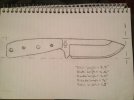Thx for the feedback. I got some good ideas. Yes 1084 because I am a newbie and everything I read says that is the best beginner steel. I am not going to sell it, nor could I probably. I just want to learn and keep it as my first knife. I did model aspects of it after the bk14 and some other knives that I like and seemed like a relatively simple design. The whole is just for function as I like to be able to tie knives to stuff if needed. What do you mean by jimping being messed up a lot? Something I might want to try. Any advice? Yes the holes/screws def need work. I also need to figure out the angle of the primary bevel. The secondary bevel will be around 20 degrees. I will post pictures as I go but I need to order some steel first. For now I better just be ready to shovel. Thanks again guys.
What was said above about the jimping +1, also CNC'd jimping can be bad in terms of comfort if poorly designed (e.g. Spyderco), best to leave it off when unnecessary.
Regarding the hole in the center of the ricasso, I discourage it as a stress-riser that may compromise integrity ... but if it's a signature-feature then go for it and see what happens.
Regarding the primary bevel-angle, you're thinking about it wrong. Angle is simply a description of the blade's thickness as it tapers from spine to edge. What you need to decide on is
how thick you want the blade to be, i.e. how stiff and strong to resist lateral flex at the cost of cutting efficiency.
Thin cuts. You mentioned that the spine will be ~1/8" thick, but how thin do you want the knife to be
behind the edge, i.e. at the shoulder where the primary bevel meets that 20-degree edge-bevel? The most efficient cutters are <0.010", "hard-use" blades are generally >0.020" for greater durability. Decide what edge-thickness you want on the blade, then decide where you want the primary grind to start near the spine - full-flat or something of a saber-grind, etc. Then simply grind the blade (however wide it may be) so as to maintain the desired bevel-height and so as to achieve the desired edge-thickness. The grind-angle is simply whatever accomplishes that, and you can grind flat or hollow or convex. Remember, it's not the
angle that matters, it's the thickness.




